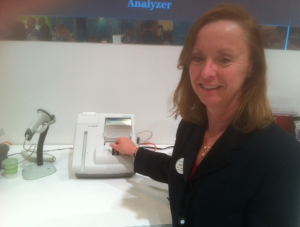Tucked away in the sprawling Siemens booth at the annual meeting of the American Association for Clinical Chemistry in Houston’s George R. Brown Convention Center is a section devoted to point of care and how some Siemens products are delivering rapid test results in emergency rooms and physicians’ offices.
Tucked away in the sprawling Siemens booth at the annual meeting of the American Association for Clinical Chemistry in Houston’s George R. Brown Convention Center is a section devoted to point of care and how some Siemens products are delivering rapid test results in emergency rooms and physicians’ offices. My guides through this wonderland were Maria Fiorino and Lauren Foohey, the domestic and global marketing directors, respectively, for Siemens point of care business.
One of the key parts of the Siemens strategy is to make available all of the key testing mechanisms you’d find in a central lab available in a point of care environment. “We may be a laboratory diagnostics company but we’re not contained in a laboratory,” said Siemens spokesman Gian Sachdev. So all the lab solutions in the point of care settings produce the same quality of results as central labs, only much more quickly.
So in the emergency room-intensive care unit environment, Maria showed me the RAPIDLab 348EX Blood Gas System and the RAPIDLab 500 Blood Gas System. I also saw the Stratus CS Analyzer, which delivers quantitative cardiac assays for very fast patient evaluation. “Lab quality results at the point of care in much less time,” said Maria. The RAPIDComm Data Management System will handle data from blood gas, diabetes and urinalysis and provide connectivity for results to mobile devices.
In the physician’s office/clinic area, Lauren demonstrated the latest machines in advanced urinalysis testing. The DCA Vantage Analyzer, which helps clinicians to monitor diabetes patients’ glycemic control status and enables early kidney disease detection. “With a simple finger prick, the doctor can have a result in six minutes,” Lauren explained.
I also saw the various iterations of the CLINITEK family of analyzers (Status+, Connect System,) for advanced urinalysis testing. “Siemens is number one worldwide in urine testing,” she added. Urine is screened for various elements and a simple turn of the cartridge on the CLINITEK Status Connect System enables the instrument to test for pregnancy. The instrument also has wireless connectivity capability.
“These are machines traditionally found in a laboratory that can be used at the point of care and we consider point of care to be anything outside the core, central laboratory,” said Lauren. “We were one of the first companies to develop some of these point of care analyses, but we’ve followed the trend as well. All of these machines you’d mainly see outside of a central lab — physician’s offices, clinics, etc.”
The Siemens philosophy for laboratory analysis is “test smarter, run faster.” With systems designed for point of care environments, the patient is assured of more timely, sometimes even life-saving, results.